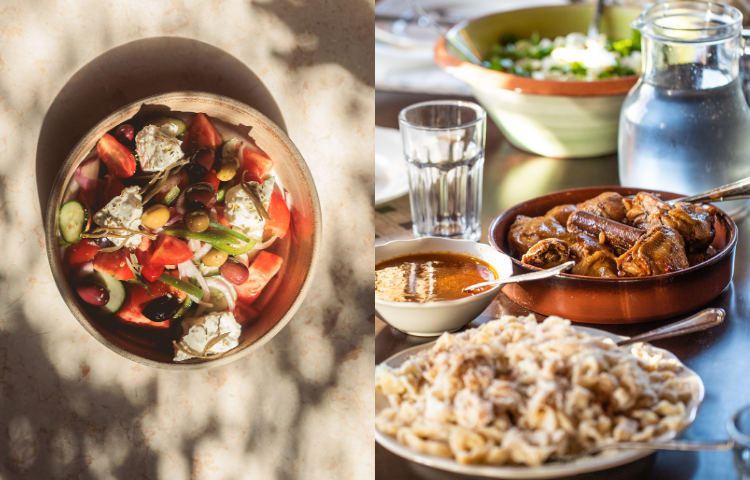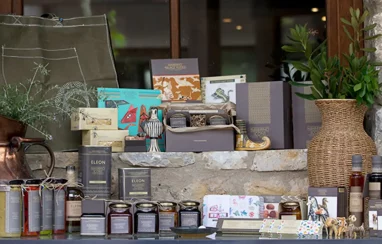By Natasha Blatsiou
There are many good things to be said about Greek cuisine. It’s one of the world’s healthiest and most popular, and praises can surely be sung to the country’s contemporary dining scene. But, more than anything, what one needs to know about Greek food is that eating is a joyous occasion here.
Above all else, the one component of the Greek Mediterranean diet that becomes more than apparent to our foreign guests is the delight of sharing. Getting together around the table is a way to preserve our cultural identity and it’s a chance for social interaction and communication, too. Invitations are always verbal and often last-minute. And if the table is set outdoors – in a garden, in a courtyard, or on a veranda (which makes sense in a country with 250 days of sunshine a year) then so much the better! After all, it’s said that the pleasure of eating begins with the eyes, and the clear sunlight brings out the natural colors of the delicious dishes spread out on the table.

A Messinian feast: the breakdown
Tradition dictates that feasts begin with a light selection of cold snacks (meze) and a glass of Greek tsipouro – a potent white spirit. The first clinking of glasses breaks the ice and guests begin to loosen up, exchanging banter and getting into the spirit of things. Then it’s all about the food!
Large platters of steaming food are laid out haphazardly. It’s all about sharing – there’s no place for individual servings, a succession of courses, or etiquette here. Everyone will try a bit of everything and then top up their plates with the dishes they like most. Fresh bread, cut into thick slices and placed in a basket, is passed around. Salads, savory pies, dips, cheeses, meats, and fish cover the table. Local gastronomy in Messinia is versatile, and the particular dishes depend on the season, but local recipes are always used. The sheer volume of food that appears at a formal meal is in stark contrast with the frugality of that served at home daily. Guests’ expectations for a feast call for variety, and even excess.
Wine and tsipouro are indelible parts of the meal. Toasts are made throughout the course of the gathering and every utterance of “To our health” (“Stin ygeia mas”) creates a growing sense of joy and togetherness. The greatest reward for the hostess is effusive praise for the food and persistent demands that she give up her culinary secrets. She will then proudly talk about the recipe that, inevitably, has been handed down for generations: the older a recipe, the better.
So long as the wine is flowing and the conversation isn’t waning, dessert can wait. The aim is not to sate your appetite as fast as you can. The essence of a Greek feast is participation, sharing, enjoying the company, and wrapping it all up with a song and a dance!

Notes for dining like a Greek:
- “Eis ygeian” (“To health”) or “Stin ygeia mas” (“To our health”), commonly shortened to just “Geia mas” are the most common toasts, heard again and again over the course of a meal.
- Using your hands or picking food out of the serving dish with your fork is common practice. Both techniques are seen as expressions of intimacy rather than bad manners.
- Using a chunk of bread to soak up the olive oil at the bottom of the salad bowl or sauce from a plate or to scoop up a dollop of dip is an important and delicious part of the gastronomical experience.
- The more you eat and drink, the happier you will make your hosts.
- The presence of children is considered nothing short of a joy. They are free to eat as much as they want, make a mess, wander around, play, and pester their parents.
- A meal can last several hours. You can either join in the fun or… exercise patience.
- As tempted as you might be, don’t smash any plates.
Local dishes to try:
- Aperitif: Tsipouro is most often served with cold hors d’oeuvres.
- Salads: Almost every Greek meal includes a Greek horiatiki (village salad) of tomato, cucumber, feta cheese, olive oil, and oregano.
- Cheese: Feta reigns supreme among all other cheeses. Messinian varieties include sfela (a semihard, whitish-yellow ewe’s cheese), kefalograviera and kefalotyri.
- Savory pies: Local varieties are often stuffed with zucchini or a selection of wild greens, flavored with herbs, and topped with sesame.
- Dips and spreads: Besides tzatziki, try tirokafteri (spicy cheese dip), taramosalata (fish roe spread), melitzanosalata (eggplant purée), and skordalia (garlic spread).
- Snacks (meze): Smoked sausage flavored with orange; fried sfela cheese; tomato or zucchini fritters; and kagianas (eggs scrambled with tomato) with cured pork are all popular local dishes.
- Main dishes: Rooster is served either with hylopites pasta or with kounoupidi kapama (cauliflower cooked in red wine). Another signature dish is xinada, made with pork and cooked leafy greens with an egg-and-lemon sauce, served with petoules, a crepe-like fritter that’s dipped in olive oil, and myzithra, a whey cheese. Other classics include lamb, roasted or fricasséed; giouvetsi (oven-baked meat in tomato sauce with orzo); stewed lamb with celery; lamb or goat baked in grease-proof paper; beef stew; and beef cooked with tomatoes and eggplant.
- Dessert: Do not leave Messinia without trying at least a couple of these classics, such as diples (honey-drenched fritters); galaktoboureko (syrup-soaked milk and semolina cake); ravani (syrup-soaked semolina cake); galopita (milk pie); fruit preserves; and lalangia (dough fritters) with petimezi (grape must).

